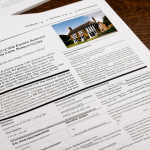Essential tax rules for leasing your second UK property
Leasing a second property in the UK involves distinct second property tax rules compared to your main residence. The key difference lies in the treatment of rental income taxation, where profits from letting are subject to specific regulations outlined by HMRC property letting guidelines. Understanding these differences is crucial to ensure full compliance and to avoid costly errors.
When it comes to rental income taxation, landlords must declare every pound earned on the property rental. This includes rent received minus any allowable deductions, but gross rental income itself is always taxable. Unlike your primary home, rental profits from a second property are not exempt from income tax and must be reported annually on your self-assessment tax return.
In the same genre : How can you leverage digital tools for UK property market analysis?
In terms of HMRC compliance, landlords leasing a second property face clear reporting requirements. This means keeping detailed financial records, reporting rental income accurately, and adhering to HMRC deadlines. Accurate declaration helps avoid penalties under HMRC property letting guidelines and ensures landlords remain compliant.
To summarize, the critical points under the second property tax rules include:
Topic to read : Revolutionizing eco-friendly homes: innovative uk bank solutions for sustainable upgrades
- Lease income must be fully declared and taxed appropriately under UK rules.
- Tax treatment differs substantially from primary residence allowances, focusing heavily on rental income taxation.
- HMRC property letting guidelines set the framework for strict reporting and compliance that landlords must follow.
Familiarity with these rules empowers landlords to manage their tax responsibilities confidently and avoid unforeseen liabilities.
Allowable expenses and maximising tax deductions
Understanding allowable expenses for landlords is essential to reduce your taxable rental income effectively. HMRC permits landlords to deduct certain costs directly related to managing and maintaining a second property. These property tax deductions typically include mortgage interest payments, letting agent fees, maintenance and repairs (but not improvements), insurance premiums, and council tax or utilities paid by the landlord.
It is important to distinguish between allowable and non-allowable expenses. For example, costs incurred on improving the property, such as extensions or significant renovations, are not deductible as running expenses but may instead affect Capital Gains Tax calculations when you sell the property. Another frequent mistake is trying to claim personal expenses or fines as allowable deductions, which HMRC rental expenses rules clearly forbid.
Good record-keeping significantly benefits landlords in maximising claims. Keeping detailed invoices, receipts, and bank statements enables precise reporting on your self-assessment tax return and helps HMRC verify your claims in case of an audit. Additionally, accurately tracking the proportion of expenses for rental use—if the property is partially occupied or used otherwise—is crucial to ensure compliance with HMRC property letting guidelines.
In summary, correctly identifying allowable expenses and maintaining comprehensive documentation allows landlords to optimise tax deductions, reducing their overall tax liability while adhering closely to HMRC’s regulatory framework.
Tax reliefs and strategies for minimising liability
Landlords leasing a second property can benefit from several landlord tax relief options designed to reduce their overall tax burden. One key relief is the finance cost relief, which allows landlords to deduct a portion of their mortgage interest from their rental income. Since mortgage interest is a significant component of property tax deductions, correctly applying this relief can substantially lower taxable profits under second property tax rules.
Additionally, the replacement of domestic items relief offers landlords the chance to claim deductions on the cost of replacing essential household items, such as furniture or appliances, without claiming for improvements. This relief is vital for maintaining compliance with HMRC property letting guidelines and maximising allowable expenses for landlords.
Effective rental property tax strategies also involve careful timing and planning. For example, timing repairs or replacements towards the end of the tax year can optimise cash flow and tax deductions. Moreover, structuring ownership to take advantage of personal allowances or a spouse’s lower tax bracket can further minimise property tax UK liabilities.
In practice, these strategies require meticulous record-keeping and awareness of changing tax rules. Engaging with expert guidance ensures landlords apply reliefs correctly while navigating complex HMRC regulations, boosting tax efficiency on their second property investments.
Capital Gains Tax considerations on a second UK property
Understanding Capital Gains Tax (CGT) on a second property is crucial for landlords looking to sell a rental property in the UK. Unlike your main home, which often qualifies for Private Residence Relief, a second property usually incurs CGT on any profit made at the point of sale. The gain is calculated by deducting the original purchase price and allowable costs, such as solicitor fees and certain home improvements, from the sale price.
You must report and pay CGT within 60 days of selling your second property, according to CGT reporting UK rules. This reporting is legally required, and failure to comply can lead to penalties from HMRC. The tax calculation considers the gain amount after deducting your annual CGT exemption allowance, which reduces your taxable profit.
To minimise CGT liability, landlords can use several strategies. One common approach is to offset allowable costs meticulously to reduce the gain. Another strategy involves transferring ownership to a spouse or civil partner to utilise their CGT allowance and potentially lower tax bands. Timing the sale to spread gains over multiple tax years may also help manage the overall tax burden.
In summary, awareness of the property sale tax implications, combined with accurate calculation and timely CGT reporting UK, helps landlords meet HMRC property letting guidelines effectively while optimising their tax position on a second property sale.
Navigating recent policy changes and compliance updates
Keeping pace with buy-to-let policy changes is vital for landlords to maintain compliance and optimise their tax position. Recent updates from HMRC have tightened rules around allowable expenses and introduced more stringent tax reporting requirements. These changes reflect the government’s goal to ensure transparency and fairness in the rental market.
One significant HMRC compliance update is the limitation on mortgage interest relief, which now restricts landlords to claiming a basic rate tax credit, instead of deducting full finance costs from rental income. This shift alters how landlord tax relief is calculated and affects overall profitability, especially under the tight framework of HMRC property letting guidelines.
In addition, landlords must be vigilant about new deadlines and reporting standards imposed by HMRC. For example, self-assessment submissions now require more detailed breakdowns of income and expenses related to second properties. Failure to meet these deadlines or properly categorise costs can result in penalties or increased scrutiny.
Staying abreast of these landlord regulation UK updates demands proactive record-keeping and familiarity with evolving tax legislation. Utilizing software tools and consulting experts can greatly assist landlords in navigating the complex compliance landscape. By adhering strictly to updated HMRC compliance updates, landlords protect themselves against audits and optimise their rental income taxation under second property tax rules.
Essential tax rules for leasing your second UK property
Leasing a second property in the UK involves navigating specific second property tax rules that differ markedly from owning your main residence. The fundamental distinction lies in the handling of rental income taxation: all income generated from the lease must be declared fully and is subject to income tax, with no exemptions typically available as there are for a primary home.
Unlike your main residence, where certain reliefs apply, second properties fall squarely under strict HMRC property letting guidelines requiring landlords to maintain transparent records of all rental income and associated expenses. This ensures correct tax calculation and compliance with HMRC’s expectations.
Landlords must adhere to detailed reporting requirements as part of HMRC compliance. These include submitting an accurate self-assessment tax return each year, declaring gross rental income, and providing a clear breakdown of allowable expenses. Failure to comply can attract penalties or trigger audits. Thus, rigorous record-keeping and timely reporting underpin compliance with these important tax rules.
In summary, understanding that your rental income from a second property is fully taxable and subject to stringent HMRC property letting guidelines allows landlords to manage their tax duties effectively and avoid costly mistakes.






